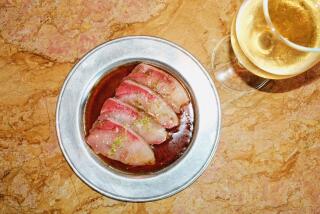RESTAURANT REVIEW : Angkor Wat Is a Temple of Cambodian Cuisine
- Share via
Angkor Wat in Cambodia was once a vast, intricate planned community built by the kings of the ancient Khmer Empire. Ransacked and burned hundreds of years ago, its exquisitely designed and carved sandstone palaces, monuments and temples sank back into the jungle.
I have only seen photographs of various wats (temples) and, unforgettably, a colossal stone carving of Vishnu’s serene countenance sitting on the forest floor wrapped in the thick roots of tropical trees. A woman I know who visited Angkor in the early 1960s, before the Cambodian borders were closed, described it as “total ruins . . . and probably the most beautiful place in the world.”
For the record:
12:00 a.m. March 17, 1989 For the Record
Los Angeles Times Friday March 17, 1989 Valley Edition Calendar Part 6 Page 27 Column 3 Zones Desk 1 inches; 18 words Type of Material: Correction
The restaurant reviewed in last Friday’s Valley Calendar was incorrectly identified. The name of the restaurant is Angkor.
Recently, while dreaming up future travel adventures, I remarked that I wanted to go to Angkor Wat. Call it prescience, coincidence, fate or synchronicity, but a week after I expressed this wish, I was sent on the job to the new Angkor Wat restaurant on Ventura Boulevard. In my daydreaming, I neglected to specify Angkor Wat, Cambodia. Once I had a spoonful of samlaw ktiss manors , a thick, sublime, velvety soup made with chicken, pineapple, red curry and tamarind, I was truly content to be in Encino.
Even if I had been able to visit Cambodia as a tourist, it is unlikely that I would have had the opportunity to sample this luscious soup for the simple reason that there are no Cambodian restaurants in Cambodia. Traditional Cambodian cuisine is eaten exclusively at home. What restaurants existed there did so only during the French colonial period and did not feature the Khmer cuisine.
Initially, Cambodians living in the United States found the concept of restaurants offering their indigenous cuisine unlikely, if not downright distasteful. But the entrepreneurial possibilities were increasingly attractive, and the first Cambodian restaurant “in history,” Phnom Penh, was opened in San Francisco in 1982. I consider it great luck that another one of these still-rare restaurants sits within easy driving distance of my home.
Cambodian cuisine is spicy, delicate, refreshing, fragrant, utterly dependent on fresh ingredients. When my friend Amy took her first bite of plear bangker , a refreshing salad of chopped prawns, bean sprouts and fresh herbs, she exclaimed: “Yes, this is the kind of food I always want to eat!”
A friendly young Cambodian couple preside over Angkor Wat’s comfortable, spare, quietly attractive dining room. They cheerfully answer questions, warn you when you may have ordered a bit too much food and administer a bit of first aid when necessary.
Everything we ate was fresh and delicious and surprising. Amy and I agreed that the prawn salad was our favorite appetizer, but the slightly denser, slightly puckery green papaya, pork and shrimp salad ran a close second. Little finger-sized, meat-stuffed spring rolls came with delicious, spicy, lightly pickled assorted vegetables.
I suspect that Cambodian food is probably a little hotter than what we were served at Angkor Wat. When our waitress delivered our soup, she warned us to avoid the red chilies floating in it. For some of us, this was warning enough.
Phil resisted the chilies in the soup, but could not resist the one he found in the otherwise mildly hot and fabulous spicy beef with fresh, sweet basil. When he was drenched in sweat, had drained all the water glasses and could begin to speak, he confessed, “I saw it, I knew what it was, and I ate it.” His discomfort was so obvious, the waitress deduced it from afar and brought him a small plate of sliced pineapple to quench the fire.
Phil recovered rapidly, spurred on by the fact that other entrees were disappearing at an alarming rate. He was especially fond of the much more delicately flavored pork with egg and winter melon, which looks and tastes like a large cucumber.
Fish dishes ranged from the very light to the very rich. A steamed filet of sole with bean threads and banana blossoms was almost Japanese in flavor. The halibut in red curry sauce with baby onions and carrots tasted strongly of coconut milk and was a little too rich for my blood, although Amy loved it.
Angkor Wat offers two wonderful desserts. There are fried bananas served with a cream custard and flamed at the table with Grand Marnier, and a jackfruit custard. The custard is also flavored strongly with coconut, but it’s topped with shreds of jackfruit, which is the big, smooth melon-type fruit one often sees in photographs of Far Eastern markets. I was delighted to find its flavor mild, but strangely compelling. Amy reminded me that whenever one eats a new fruit, one gets to make a wish. My last wish, you might remember, was to visit Angkor Wat. This time, I wished I’d get to come back soon.
Recommended dishes: nohrm lahong (papaya, pork and prawns in light lime sauce), $4.45; plear bangker (prawn salad with fresh herbs), $5.45; samlaw ktiss manors (spicy red curry chicken soup with pineapple and tamarind broth), $6.25; spicy beef with fresh sweet basil, $6.75; steamed filet of sole, bean thread, ginger and banana blossoms, $7.95.
Angkor Wat, 16161 Ventura Blvd., Encino. (818) 990-8491. Open 11 a.m. to 10 p.m. Mondays through Saturdays, 5 to 10 p.m. Sundays. American Express, MasterCard and Visa accepted. Beer and wine. Dinner for two, food only, $15 to $30.
More to Read
Sign up for The Wild
We’ll help you find the best places to hike, bike and run, as well as the perfect silent spots for meditation and yoga.
You may occasionally receive promotional content from the Los Angeles Times.






